Related Research Articles
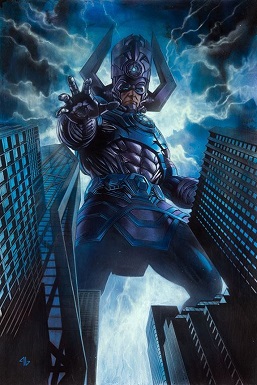
Galactus is a fictional character appearing in American comic books published by Marvel Comics. Formerly a mortal man, he is a cosmic entity who consumes planets to sustain his life force, and serves a functional role in the upkeep of the primary Marvel continuity. He was created by Stan Lee and Jack Kirby and first appeared in Fantastic Four #48.
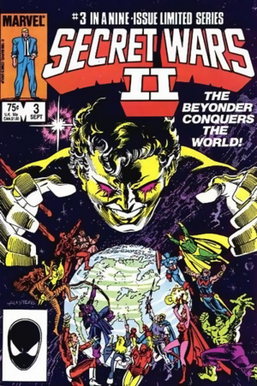
The Beyonder is a fictional cosmic entity appearing in American comic books published by Marvel Comics. Created by writer Jim Shooter and artist Mike Zeck, the Beyonder first appeared in Secret Wars #1 as an unseen, nigh-omnipotent being from outside the multiverse who kidnapped the heroes and villains of the Marvel Universe to have them do battle on Battleworld, a fictional planet created by the Beyonder. The character plays a more antagonistic role in the 1985 sequel, Secret Wars II, in which he takes human form to learn about desire but threatens to destroy the multiverse out of increasing frustration.

The cosmos is an alternative name for the universe or its nature or order. Usage of the word cosmos implies viewing the universe as a complex and orderly system or entity.
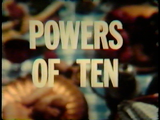
The Powers of Ten films are two short American documentary films written and directed by Charles and Ray Eames. Both works depict the relative scale of the Universe according to an order of magnitude based on a factor of ten, first expanding out from the Earth until the entire universe is surveyed, then reducing inward until a single atom and its quarks are observed.
A parallel universe, also known as an alternate universe, parallel world, parallel dimension, alternate reality, or alternative dimension, is a hypothetical self-contained plane of existence, co-existing with one's own. The sum of all potential parallel universes that constitute reality is often called a "multiverse". While the six terms are generally synonymous and can be used interchangeably in most cases, there is sometimes an additional connotation implied with the term "alternate universe/reality" that implies that the reality is a variant of our own, with some overlap with the similarly named alternate history.

Cosmic Boy is a superhero appearing in comics published by DC Comics. He is from the 31st century, and is a founding member and original leader of the Legion of Super-Heroes.

Physics World is the membership magazine of the Institute of Physics, one of the largest physical societies in the world. It is an international monthly magazine covering all areas of physics, pure and applied, and is aimed at physicists in research, industry, physics outreach, and education worldwide.
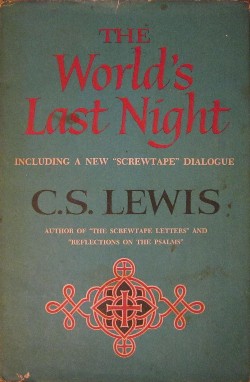
The World's Last Night and Other Essays is a collection of essays by C. S. Lewis published in the United States in 1960. The title essay is about the Second Coming of Jesus Christ. The volume also contains a follow-up to Lewis' 1942 novel The Screwtape Letters in the form of "Screwtape Proposes a Toast." The second, fourth and fifth pieces were published in the U.K. in a volume called Screwtape Proposes a Toast and other pieces (1965); the first, sixth and seventh were published in the U.K. in Fern-seed and Elephants and other essays on Christianity (1975). All the pieces were later collected in the comprehensive Essay Collection and Other Short Pieces (2000).
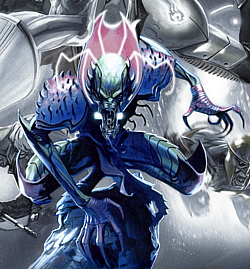
Annihilus is a supervillain appearing in American comic books published by Marvel Comics, primarily as an adversary to the Fantastic Four. The character debuted in Fantastic Four Annual #6, which was published in November 1968. Annihilus was created by writer Stan Lee and artist Jack Kirby, and was notably featured in the "Annihilation" event.
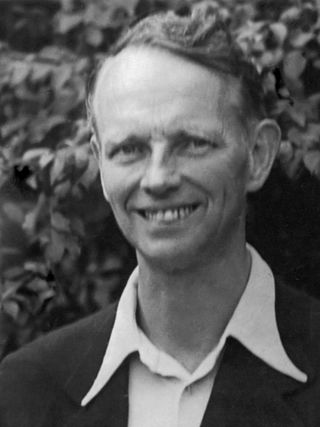
Cornelis "Kees" Boeke was a Dutch reformist educator, Quaker missionary and pacifist. He is best known for his popular essay/book Cosmic View (1957) which presents a seminal view of the universe, from the galactic to the microscopic scale, and which inspired several films.

The Rose Center for Earth and Space is a part of the American Museum of Natural History in New York City. The Center's complete name is The Frederick Phineas and Sandra Priest Rose Center for Earth and Space. The main entrance is located on the northern side of the museum on 81st Street near Central Park West in Manhattan's Upper West Side. Completed in 2000, it includes the new Hayden Planetarium, the original of which was opened in 1935 and closed in 1997. Neil deGrasse Tyson is its first and, to date, only director.

Cosmic Voyage is a 1996 short documentary film produced in the IMAX format, directed by Bayley Silleck, produced by Jeffrey Marvin, and narrated by Morgan Freeman. The film was presented by the Smithsonian Institution's National Air and Space Museum, and played in IMAX theaters worldwide. The film is available in the DVD format.
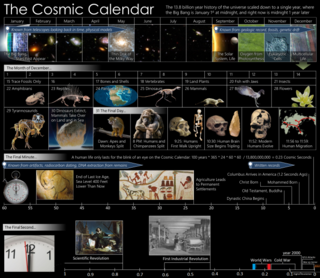
The Cosmic Calendar is a method to visualize the chronology of the universe, scaling its currently understood age of 13.8 billion years to a single year in order to help intuit it for pedagogical purposes in science education or popular science.
Cosmic Zoom is a 1968 short film directed by Robert Verrall and produced by the National Film Board of Canada. It depicts the relative size of everything in the universe in an 8-minute sequence using animation and animation camera shots. All drawings by Eva Szasz.

Knowledge of the location of Earth has been shaped by 400 years of telescopic observations, and has expanded radically since the start of the 20th century. Initially, Earth was believed to be the center of the Universe, which consisted only of those planets visible with the naked eye and an outlying sphere of fixed stars. After the acceptance of the heliocentric model in the 17th century, observations by William Herschel and others showed that the Sun lay within a vast, disc-shaped galaxy of stars. By the 20th century, observations of spiral nebulae revealed that the Milky Way galaxy was one of billions in an expanding universe, grouped into clusters and superclusters. By the end of the 20th century, the overall structure of the visible universe was becoming clearer, with superclusters forming into a vast web of filaments and voids. Superclusters, filaments and voids are the largest coherent structures in the Universe that we can observe. At still larger scales the Universe becomes homogeneous, meaning that all its parts have on average the same density, composition and structure.
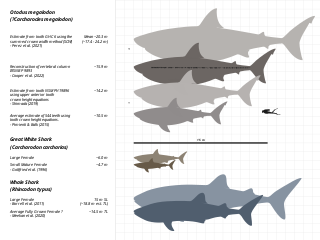
Size in general is the magnitude or dimensions of a thing. More specifically, geometrical size can refer to three geometrical measures: length, area, or volume. Length can be generalized to other linear dimensions. Size can also be measured in terms of mass, especially when assuming a density range.
Cosmic Eye is a short 2012/2018 film and iOS app, developed by astrophysicist Danail Obreschkow. It shows the largest and smallest well known scales of the universe by gradually zooming out from and then back into the face of a woman called "Louise". According to the creator, the film and app were inspired by the essay Cosmic View (1957) and the short films Cosmic Zoom (1968) and Powers of Ten (1977), but use state-of-the-art technology and new scientific imaging and computer simulations. Cosmic Eye, although developed in 2012 for local teaching and outreach purposes, in April 2016 it suddenly attracted 40 million views in just ten days on the Facebook group page of "The Science Scoop". The video has since been viewed more than 200 million times on Facebook and was featured in major media, such as BBC World News.

Kid Cosmic is an American animated superhero television series created by Craig McCracken and developed by McCracken, his wife Lauren Faust and Francisco Angones for Netflix. The series was based on his 2009 comic The Kid from Planet Earth. Produced in-house by Netflix Animation, the show is McCracken's first to have a serialized format, as well as his second foray into the superhero genre, having previously created The Powerpuff Girls. Illustrated in a "retro 2D" style inspired by comics such as Dennis the Menace and The Adventures of Tintin, the series follows Kid, a young boy who gets a chance to become a superhero and fight evil aliens alongside other characters with different abilities.

Timelapse of the Entire Universe is a 2018 short epic animated pseudo-documentary web film created by American astronomy-themed musician and filmmaker John D. Boswell. Inspired by the Cosmic Calendar, the 10-minute film is a hyperlapse of the universe from its start to current humanity, with every second representing 22 million years, with the entire humanity represented in a short time, using current knowledge. The film was originally released on Boswell's YouTube channel Melodysheep on March 7, but it was eventually taken down due to a copyright infringement regarding Morgan Freeman's voice. A revised version was uploaded 3 days later, on March 10, 2018. A year and 10 days later, a follow-up, Timelapse of the Future, was released.

The Scale of the Universe is an interactive online visualization tool first created in 2010 by Cary and Michael Huang, two brothers from Moraga, California. It features a scrollbar that players can use to navigate orders of magnitude and various objects within such size ranges. Sliding the scrollbar to the left and right causes the screen to zoom in and out respectively.
References
- Gateway to the Great Books, edited by Robert Maynard Hutchins and Mortimer Adler, Encyclopædia Britannica Inc. 1963, volume 8, pp. 597–644